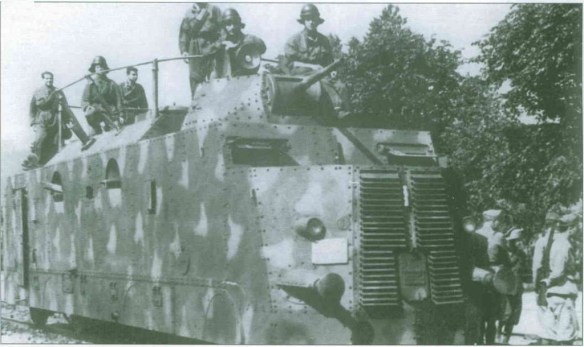In 1942 it was decided to armour the ALn-556 railcars of the Ansaldo firm, for service in Yugoslavia. The Railway Engineers chose models produced from 1936 to 1938. They had to be shortened by 5.60m (18ft 4½in). The prototype was tested in the Ansaldo-Fossati workshops in Genoa, and was adopted on 5 September 1942, with several recommended changes, with the designation ‘Littorina blindata mod. 42 (Li.Bli 42)’. The first production model was rolled out on 20 September and joined the 1o Compagnia Autonoma Littorine Blindate. This company would receive eight railcars in total, and was made up of ten officers, twelve NCOs and 167 men. The 8.5mm armour protection was built in one piece, pierced only by access and maintenance hatches, and firing ports.
Armed with two tank turrets mounting 47mm guns, two versions were used at the same time. The first version had two openings in the roof to allow firing two 81mm Model 35 mortars, or flamethrowers through side apertures. The second had a circular tub with a pedestal-mounted 20mm Breda Model 35 cannon. The 8.5mm armour protection was built in one piece, pierced only by access and maintenance hatches, and firing ports.
When the Italian Armistice was signed, the ‘Liblis’ were based at Karlovac, Ogulin and Split (Croatia), Ljubljana and Novo Mesto (Slovenia) and Suse (in Italy, 30km/19 miles west of Turin). A series of machines was then ordered for the Wehrmacht in 1943.
The Independent Railway Company saw hard service up until the Armistice of 1943, and suffered heavy losses. In particular two ‘Libli’ were destroyed, the first at Split in October 1942 and the second at Ogulin on 12 February 1943.
Technical specifications:
Length: 13.50m (44ft 71/2in)
Width: 2.42m (7ft 111/4in)
Height: 3.57m (11ft 81/2in)
Weight: 39.5 tonnes
Motor: FIAT 355C, 80hp at 1700 rpm
Fuel: Diesel
Maximum speed: 80km/h (50mph)
Range: 450km (280 miles)
Armour thickness: 8.5mm
Armament: 2 turrets similar to those fitted to the M13/40 tank, with 47mm/L32 gun with 195 rounds and 8mm Breda 38 machine gun
Either 2 x 81mm Mod. 35 mortars with 576 bombs Or 1 x 20mm Breda Mod. 35 anti-aircraft cannon
2 Mod. 40 flamethrowers
4 x 8mm Breda 38 machine guns in side ball mountings with 8,040 rounds
The personal arms of the crew and hand grenades
Crew: 1 officer, 2 drivers, 2 gunners, 2 loaders, 6 machine gunners, 2 mortar specialists, 2 flamethrower engineers, 1 radio operator
Radio equipment: Marelli RF2CA or RF3M set
Various: Turret searchlights, track repair equipment.
